|
|||||||||||||
|
|||||||||||||
|
|
|||||||||||||
|
|||||||||||||
|
Com esta mensagem de Ano Novo, saúdo toda a comunidade da SBPMat, no Brasil e no exterior.
É grande a expectativa de que a partir de 2019 o Brasil retome os investimentos em ciência, tecnologia e inovação, que possam ser considerados como minimamente necessários para a manutenção de nosso sistema, desenvolvido com muito esforço nas últimas décadas. Para a reunião que a comunidade acadêmica teve com o futuro ministro da ciência e tecnologia no início de dezembro de 2018, a SBPMat enviou como sugestão principal a recomposição do orçamento da área. Sabe-se que o Brasil precisa investir muito mais na geração de conhecimento para resolver seus graves problemas econômicos e sociais. Recuperar o orçamento é apenas o primeiro e mais urgente dos passos, em face da situação das universidades e centros de pesquisa no País. São também relevantes, e fizeram parte das sugestões da SBPMat, a ênfase em parcerias entre ministérios para abordar problemas da sociedade de grande abrangência que sempre requerem ciência, tecnologia e inovação, e a busca de sinergia com o setor privado para transformar conhecimento em riqueza e bem-estar social.
A área de materiais, em particular, tem se mostrado essencial para todo e qualquer tipo de desenvolvimento. Desde as descobertas fundamentais de ciência básica para a compreensão da natureza e conquista do espaço, até aplicações em medicina e agricultura, áreas que hoje progridem enormemente a partir de novos materiais e metodologias criadas para estudá-los. No Brasil, por exemplo, a inauguração da primeira etapa do Sirius, nova fonte de luz síncrotron, no Centro Nacional de Pesquisa em Energia e Materiais, revelou uma obra prima da ciência e engenharia de materiais. Ainda mais relevante é que grande parte dessa tecnologia é brasileira.
A SBPMat tem se empenhado continuamente em prover um espaço para que pesquisadores, do Brasil e exterior, possam comunicar e debater suas contribuições científico-tecnológicas, e buscar parcerias para novos desafios num campo altamente multidisciplinar. Nosso último Encontro em Natal (RN), em setembro de 2018, repetiu o sucesso de edições anteriores com essa perspectiva. Alguns dos muitos avanços da ciência e tecnologia em materiais foram destacados nos Boletins da SBPMat, como uma amostra do trabalho de qualidade que se faz no Brasil. A SBPMat também considera estratégica a divulgação científica. Em 2018 criou uma nova série do Boletim, denominada “Da ideia à inovação”, com reportagens especiais sobre o impacto de tecnologias que chegaram à sociedade.
Finalizo agradecendo à comunidade da SBPMat, desejando saúde e sucesso em 2019, na expectativa de encontrar muitos de vocês no Balneário Camboriú (SC), de 22 a 26 de setembro, para o nosso próximo Encontro.
Professor Osvaldo Novais de Oliveira Junior
Presidente da SBPMAT
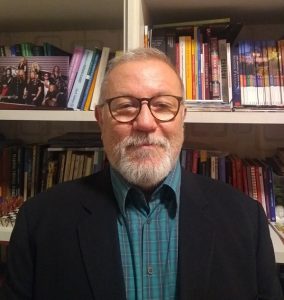
O professor Sidney José Lima Ribeiro (UNESP Araraquara), sócio da SBPMat, foi eleito Fellow da European Academy of Sciences (EurASc) neste mês de dezembro.
Os Fellows da EurASc são eleitos por meio de um processo que envolve uma indicação feita por um membro da sociedade, quem deve apresentar informações curriculares do nominado e cartas de indicação e apoio, e a aceitação da candidatura por parte do Conselho Geral da sociedade. Depois disso, o candidato é convidado a ser Fellow.
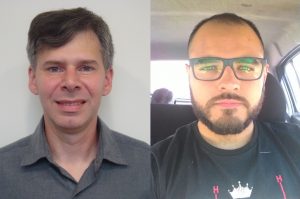
Os sócios da SBPMat Sérgio Ricardo de Lázaro (professor da UEPG) e Luis Henrique da Silveira Lacerda (doutorando no UEL/UEPG/UNICENTRO) são autores do livro “Teoria do Funcional da Densidade e Propriedades dos Materiais”, publicado pela editora CRV. O livro tem coautoria de Renan Augusto Pontes Ribeiro, também doutorando do programa. A Teoria do Funcional da Densidade é baseada na Mecânica Quântica e foi aplicada na área de Química de Materiais.
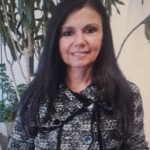
A professora Luciana Reyes Pires Kassab (Faculdade de Tecnologia de São Paulo), sócia da SBPMat, é coeditora do livro Metal Nanostructures for Photonics. Publicado pela editora Elsevier, o livro aborda as propriedades e aplicações fotônicas de nanoestruturas metálicas, bem como as técnicas de preparo e caracterização desses materiais. A professora Luciana R. Pires Kassab editou o livro junto ao professor Cid Bartolomeu de Araujo (UFPE). Mais de 40 autores de diversos países assinam os 12 capítulos do livro.
Mais informações sobre o livro: https://www.elsevier.
|
||||||||||||||||||||||
|
||||||||||||||||||||||
|
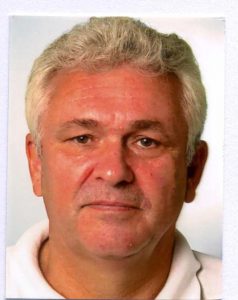
In the late 1970s, when he was a doctoral student, German scientist Heinz von Seggern came to Brazil for the first time and met some local researchers with whom he still collaborates. His host was Bernhard Gross, another German scientist who settled in Brazil and is considered a pioneer of materials research in the country. This was the beginning of a series of scientific visits of Heinz von Seggern to Brazil, which included the participation in five B-MRS Meetings, the annual events of the Brazilian Materials Research Society. In the last edition of the event, Prof. Heinz von Seggern gave a plenary lecture on ferroelectrets.
Heinz von Seggern graduated in physics from the University of Hannover (Germany) in 1976. He received his PhD degree in electrical engineering from the Technical University of Darmstadt (Germany) in 1979. His thesis advisor was Prof. Gerhard Sessler, one of the inventors of the electret microphone, the most common type of microphone in use today. After that, Heinz von Seggern became a postdoc and then a principal investigator at AT&T Bell Laboratories (USA). From 1985 to 1997 he worked at Siemens research center in Erlangen (Germany), starting as a principal investigator and then being promoted to department head. Since 1997, he is Full Professor at the Technical University of Darmstadt, where he leads the Electronic Materials Group.
Throughout four decades of scientific research, Heinz von Seggern has made important contributions to the field of materials in understanding fundamental phenomena, developing analysis techniques and applications, and inventing devices. He has published over 280 scientific papers in peer-reviewed journals with more than 7.800 citations, and his h-index is 46 (Google Scholar).
See our interview with this scientist.
B-MRS Newsletter: – What motivated you to become a scientist and, particularly, a materials scientist?
Heinz von Seggern: – Already as a high school student my main interest was directed towards natural science. This passion was strongly motivated by one of my teachers who really understood to ignite my love for this field. So it was a natural thing for me to study physics, however, I always kept in touch with mathematics and chemistry. After finishing my diploma in physics at the Technical University of Hannover, I started my PhD work at the Technical University of Darmstadt in the electrical engineering department and two and a half years later I received my doctoral degree in electrical engineering. The following four out of five years I spend at Bell Laboratories in Murray Hill, New Jersey, USA whose fabulous working conditions made my bonds to science even stronger. My path to materials science started with my return to the Corporate Research Laboratories of Siemens AG in Erlangen where I spend 12 years before being appointed as full professor at the Technical University of Darmstadt, Germany. In the time at Siemens my work was focused on more practical aspects of science which I started to be increasingly interested in. The ability to change and adapt material properties to practical demands, which is the basic task of materials science, fascinated me more and more.
B-MRS Newsletter: – In your opinion, what are your main contributions to the materials field? Please, select a couple of discoveries/developments, describe them briefly, describe the context in which they were developed, and share the papers or patents references.
Heinz von Seggern: – Since I have been working on different subjects it is not so easy to point out my or our major contributions to the materials field. I will concentrate on one discovery or development in each field. Let’s start with my PhD study. My task was to understand the charge transport and electronic trap structure of Teflon FEP thin films to back up the lifetime expectation of electret microphones. I discovered by means of thermally stimulated discharge measurements that Teflon FEP contains two different types of energetically deep electron traps which are located near the surface and in the bulk of the films, respectively. This discovery was made possible by comparing TSD results of corona and electron beam charged samples whereby corona charging leads to filling of traps close to the surface and electron-beam charging allowed for deposition of charge into surface and bulk traps dependent on the utilized electron energy. From this finding a charge transport model was developed depending on the initial location of the electrons after charging. The model is based on trapping and thermally induced release. In case of corona charging the transport is initiated by a thermally induced release of electrons from surface traps and a subsequent capture and release by deeper bulk traps [Ref: H. von Seggern, J. Appl. Phys. 50, 7039 (1979), Heinz von Seggern, J. Appl. Phys. 50, 2817 (1979)]. The morphological reason for the different trap depth of surface and bulk can be seen in the film production process where different cooling rates apply to the surface and the bulk of the films.
After finishing my PhD degree I continued this research at Bell Laboratories investigating the transport of positive charges. In contrast to the electron traps, hole traps are relatively shallow and are distributed through the complete film. Once filled they empty relatively fast already at room temperature. On the other hand the number to energetically deep traps was found to be rather small resulting in a low capture rate. This implies that holes have a high probability to penetrate the film via hopping through shallow traps without being captured by deep traps which implies a rather low charge stability of Teflon FEP for holes. We were able to show that this problem can be circumvented by charging at high temperatures filling only deep traps [H. von Seggern, J. West, J. Appl. Phys. 55, 2754 (1984)]. This charge stabilization for positive charges recently became important with respect to so called piezoelectrets where by symmetry breaking a novel piezoelectric material was generated utilizing only nonpolar components. For these devices the stability of both charge types is essential.
During my time at the Corporate Research Labs of Siemens AG in Erlangen the field of interest changed to x-ray storage phosphors which are currently applied in so called image plates used commercially in x-ray diagnostics. The image plate thereby combines the classically utilized silver halide film and the intensifying screen where latter was applied to convert incoming x-rays to visible photons which are then detected by the photographic silver halide film. The working principle of the image plate is that by x-ray exposure electrons and holes are generated and trapped as F-centers and Vk-centers, respectively. Readout occurs by photostimulation of the electron and radiative recombination with the Vk-center. The released energy is then converted to a rare earth ion which emits light at its characteristic wavelength. Thereby the intensity of the emitted photons is indicative for the locally absorbed x-ray dose. My major contribution to this field was the discovery of the basic working principle of these photostimulable phosphors and the existence of spatially correlated and uncorrelated PSL centers which allowed for a deeper insight into the physics of storage phosphors [H. von Seggern et al., J. Appl. Phys. 64, 1405 (1988)]. Another contribution was the invention of neutron image plates fabricated by mixing an effective neutron absorber to the granular storage phosphor particles [T. Bücherl, H. von Seggern et al., Nucl. Instr. Meth. A333, 502 (1993)]. This technique is still widely used in neutron image detection.
After accepting the position as full professor in Materials Science at the Technische Universität Darmstadt I concentrated my efforts on the field of Organic Electronics which I already started at Siemens some years before. In the first years we focused on the energetic trap distribution of organic semiconductors. We were the first to experimentally prove the existence of a Gaussian trap distribution predicted earlier by Bässler et al. through Monte Carlo simulation. The experimental method used a refined thermally stimulated discharge technique known as fractional discharge, where a stepwise increase in temperature combined with the corresponding thermal release of charge allows one to determine the trap distribution which up to now is the only technique known to directly determine the distribution of traps [N. von Malm et al., J. Appl. Phys. 89, 5559 (2001); R. Schmechel et al., Phys. Stat. Sol. (a) 201, 1215 (2004)]. The largest scientific attention we received, however, for the invention of the organic light emitting transistor (OFET) based on tetracene and a polyfluorene derivative. In such OFETs it was shown to be possible to obtain ambipolar transport by injection of electrons and holes from source and drain, respectively [A. Hepp, H.von Seggern et al., Phys. Rev. Let. 157406, 1 (2003); M. Ahles, H. von Seggern et al., Appl. Phys. Let. 84, 428 (2004)]. It was also shown that the same ambipolar transport can be used to construct colour tunable OFETs [E. J. Feldmeier, H. von Seggern et al., Adv. Mater 22, 3568 (2010)] where the motion of the emissive recombination zone through the transistor channel is used to excite different overlaying organic semiconductors with different emission wavelength.
In the last years at TU Darmstadt I have revisited charge storage in organic polymers known as ferro- or piezoelectrets. The cellular polymer polypropylene has shown by Finnish scientists to exhibit large piezoelectric d33 coefficients after poling by high electric fields with the only disadvantage that the trapped charge turned out to be thermally unstable. Therefore structures changed quickly to Teflon based sandwiches of solid FEP /ePTFE/ solid FEP, where ePTFE is a highly porous PTFE consisting of up to 98% air, and later to completely air filled structures. My contribution to that field is the physics explaining the hysteresis and thereof the deduction of the maximal stable polarization which then allows for the theoretical deduction of the piezoelectric d33 coefficient for plane-parallel structures. This knowledge allows for the optimization of the piezoelectric effect and therewith increases the potential for future applications [S. Zhukov, H. von Seggern et al., J. Appl. Phys. 102, 044109 (2007); S. Zhukov, H. von Seggern et al., Scientific reports 8, 4597 (2018)].
B-MRS Newsletter: – Please make a brief story of your interaction with Brazil and with Prof Bernhard Gross.
Heinz von Seggern: – During my PhD work at TU Darmstadt Prof. Gross was a frequent guest of Prof. G.M. Sessler, my thesis adviser. Before my final PhD defense he invited me to visit the Institute of Physics of the University of Sao Paulo (USP) in Sao Carlos. Here I met all the people with whom I am still in contact and friendship with, namely Roberto M. Faria and Jose A. Giacometti who in the meantime have become established professors at USP. After finishing my PhD study I went to Bell Laboratories, Murray Hill, NJ. where Profs. Gross and Sessler were welcomed guest almost every year. The collaboration was extremely fruitful and resulted in a number of joint publications. In 1984 I then left Bell Labs and started to work at Siemens Corporate Research on different topics for the next 12 years and naturally the collaboration was at rest. But as soon as I became appointed Professor at TU Darmstadt I revitalized my connection to the Institute of Physics of Sao Carlos, whose polymer group is now called Grupo de Polimeros “Prof. Bernhard Gross”. From that year on I visited initially Prof. Giacometti and later Prof. Faria almost yearly for up to two month financed generously by FAPESP through various programs. These stays were always very enjoyable and busy, and quite a few publications have resulted.
B-MRS Newsletter: – How many times did you attend the B-MRS Meetings? Do you remember when was the first time?
Heinz von Seggern: – In total I have attended five Brazilian MRS meetings starting in Natal 2007, Florianopolis 2012, Joan Pessoa 2014, Rio de Janeiro 2015 and again Natal in 2017. My first stay in Natal 2007 I remember especially since I was allowed to present our work in front of a great audience on the recently discovered light emitting organic field effect transistor and, on a more personal note, I also remember the wonderful Caipirinha my wife and me were enjoying every evening during sunset at the ocean side.
B-MRS Newsletter: – You have about 40 years of strong experience as a researcher. Please leave a short message with some advice for the students and junior scientists of our community.
Heinz von Seggern: – In the context of scientific education Prof. Bernhard Gross once said to me: “For someone who knows nothing, everything is possible.” There is a lot of truth in these few words. We all tend to sometimes talk about things that seem to be obvious to us but in reality they are not. My advice therefore is, especially to young scientists, to always ask yourself whether you understand the physical and/or chemical grounds of your current research. If not I suggest to you to acquire the missing basics, which then allows you to select from “everything is possible” the physical meaningful trials. This will definitely help you to make the right decisions to continue your research in a meaningful way.
O artigo científico com participação (liderança) de membros da comunidade brasileira de pesquisa em Materiais em destaque neste mês é: Evidence of Band-Edge Hole Levels Inversion in Spherical CuInS2 Quantum Dots. Gabriel Nagamine, Henrique B. Nunciaroni, Hunter McDaniel, Alexander L. Efros, Carlos H. de Brito Cruz, and Lazaro A. Padilha. Nano Lett., 2018, 18 (10), pp 6353–6359. DOI: 10.1021/acs.nanolett.8b02707.
Pontos quânticos com regras únicas
 Um trabalho liderado por pesquisadores da Unicamp revelou surpreendentes novidades sobre as regras que determinam os níveis de energia dos elétrons em pontos quânticos de dissulfeto de cobre e índio (CuInS2), os quais se destacam na família dos pontos quânticos por serem atóxicos. O trabalho foi recentemente reportado no periódico científico Nano Letters (fator de impacto 12,08).
Um trabalho liderado por pesquisadores da Unicamp revelou surpreendentes novidades sobre as regras que determinam os níveis de energia dos elétrons em pontos quânticos de dissulfeto de cobre e índio (CuInS2), os quais se destacam na família dos pontos quânticos por serem atóxicos. O trabalho foi recentemente reportado no periódico científico Nano Letters (fator de impacto 12,08).
Os resultados do estudo, confirmados por métodos experimentais e teóricos, mostraram uma situação na estrutura de bandas de energia que nunca antes tinha sido observada em outros materiais.

A estrutura de bandas é um modelo científico bem estabelecido que mostra quais estados ou níveis de energia os elétrons podem ocupar em um determinado material. Esses estados de energia são representados em forma de bandas permitidas (aquelas que os elétrons podem atingir) e bandas proibidas (aquelas em que os elétrons não podem ser encontrados).
Em semicondutores, as bandas de energia que são permitidas para um elétron e que determinam as propriedades de um material são a banda de valência e a de condução. Ambas estão separadas por uma banda proibida (band gap). Para que elétrons “pulem” da banda de valência à de condução, transpondo a banda proibida num processo denominado transição, é necessário que recebam energia extra, o que pode ocorrer quando o material absorve fótons. Ao perderem energia, esses elétrons podem voltar a ocupar seus lugares na banda de condução, e a energia excedente pode ser emitida em forma de fótons (luz). Essa emissão de luz decorrente da absorção de fótons é conhecida como fotoluminescência.
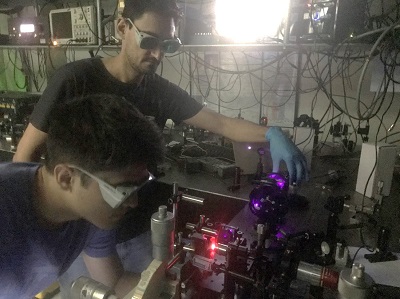
Fazendo experimentos no Laboratório de Fenômenos Ultrarrápidos do Instituto de Física Gleb Wataghin (UNICAMP), os pesquisadores brasileiros descobriram que os pontos quânticos que estavam estudando não seguiam as mesmas regras de transição que os demais materiais e nanomateriais semicondutores. “De forma geral, em semicondutores, bulk ou nanoestruturados, os estados que formam o topo da banda de valência e o fundo da banda de condução são tais que uma transição entre esses estados, por absorção de um fóton, é permitida”, contextualiza Lázaro Aurélio Padilha Junior, professor da UNICAMP e autor correspondente do artigo. “O que mostramos foi que, no material estudado (pontos quânticos de CuInS2), essa transição é proibida por absorção de um fóton, sendo necessária a interação com dois fótons para que essa transição ocorra. Até onde sabemos, esse é o primeiro sistema semicondutor que apresenta essa inversão de estados”, conta Padilha.
A descoberta, além de mostrar que as normas que regem os estados dos elétrons em semicondutores não valem para todos os materiais, pode ter impacto nas aplicações dos pontos quânticos estudados. De acordo com Padilha, as condições descobertas favorecem a emissão simultânea de dois fótons no material quando os elétrons voltam à banda de condução. “Isso poderia ser atrativo para sistemas lasers que emitiriam luz em duas cores distintas ao mesmo tempo, e com ajuste de cor em uma larga faixa espectral”, diz o professor. Além disso, acrescenta Gabriel Nagamine, primeiro autor do artigo, entender a estrutura de bandas do material pode melhorar o desempenho de aplicações já existentes, como os concentradores solares luminescentes – uma tecnologia que podem ser utilizadas tanto para gerar energia elétrica a partir da luz solar quanto para aumentar a produção de alimentos em estufas. “Todas essas aplicações advêm das características únicas das bandas eletrônicas desses materiais”, diz Nagamine.
História de um resultado experimental teoricamente anunciado
A história desta descoberta remonta ao ano de 2015, quando o professor Padilha, que trabalha com pontos quânticos desde 2010, seu aluno de mestrado Gabriel Nagamine e outros membros do grupo de pesquisa decidiram investir esforços em estudar os pontos quânticos de CuInS2. “Esse material chamou nossa atenção por não possuir metal pesado em sua composição, o que o tornava interessante para aplicações em Biologia e Medicina, como, por exemplo, marcadores biológicos fluorescentes”, conta Padilha. De fato, os pontos quânticos, que foram descobertos na década de 1980 e já estão presentes em produtos como telas de TV, apresentam propriedades muito interessantes para serem usados na detecção de doenças e outras aplicações na área de saúde, mas quase todos eles são tóxicos devido a sua composição química.
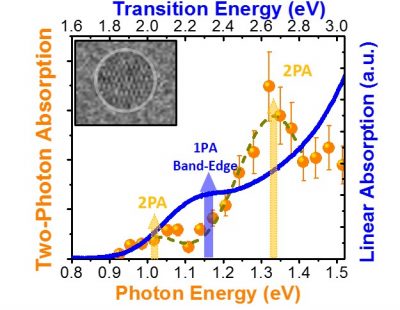
A equipe da UNICAMP fez então uma colaboração com a empresa UbiQD, localizada em Los Álamos (Estados Unidos) e especializada na produção de pontos quânticos, pela qual a firma forneceu amostras de pontos quânticos esféricos e piramidais. A caracterização das amostras foi realizada parcialmente na empresa e também no Laboratório Nacional de Nanotecnologia (LNNano) do CNPEM, na cidade de Campinas (SP, Brasil).
Inicialmente, Padilha e sua equipe se propuseram a investigar quão forte era a absorção de dois fótons no material escolhido, já que esse processo óptico permite fazer imagens tridimensionais de material, que podem ser muito úteis na sua caracterização e também em sua aplicação em diversas áreas. Para isso, no início de 2016, a equipe realizou os experimentos principais do trabalho no IFGW-UNICAMP usando uma técnica de espectroscopia que permite detectar emissão de luz proveniente da absorção de dois fótons. “As primeiras medidas revelaram um pico de absorção de dois fótons a energias menores que as da absorção linear – fato nunca antes observado experimentalmente”, conta Padilha. “Achamos que poderia ser algum problema em nossa fonte laser e repetimos o experimento, obtendo os mesmos resultados”, relata. Esses resultados, que são exibidos na figura ao lado, surgiram dos experimentos realizados com pontos quânticos esféricos. Já nas amostras de pontos quânticos com formato de pirâmide, a predominância da absorção de dois fótons não foi observada.
Em maio do mesmo ano, Padilha encontrou-se com o Dr. Alexander Efros, do National Research Laboratory (EUA) em uma conferência na Coréia do Sul. “Ele, que é um dos mais respeitados teóricos que trabalham com estrutura eletrônica de pontos quânticos semicondutores, mencionou que havia feito uns cálculos que previam uma inversão na paridade dos estados nesses nanomateriais. Imediatamente notamos que eu tinha provado a teoria dele”, relata o professor da UNICAMP. Os cientistas começaram então a trabalhar juntos e a tentar entender outros aspectos do problema, até submeter o artigo à Nano Letters. O paper foi aceito em menos de dois meses.
A pesquisa que originou o artigo faz parte da dissertação de mestrado de Gabriel Nagamine, defendida em 2017 pelo IFGW-UNICAMP, e recebeu apoio financeiro de agências brasileiras de apoio à pesquisa (a paulista FAPESP e a federal CNPq), do serviço de apoio ao estudante (SAE) da UNICAMP e do Office of Naval Research (Estados Unidos).
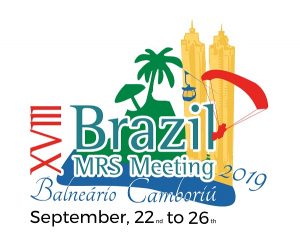 Saiba quais serão as palestras plenárias e a palestra memorial do XVIII B-MRS Meeting (Balneário Camboriú, 22 a 26 de setembro de 2019).
Saiba quais serão as palestras plenárias e a palestra memorial do XVIII B-MRS Meeting (Balneário Camboriú, 22 a 26 de setembro de 2019).
Memorial Lecture
Prof. Yvonne Primerano Mascarenhas
Instituto de Física de São Carlos – USP
Plenary Lectures
Prof. Julia Greer
California Institute of Technology – USA
Title: Materials by Design: Three-Dimensional Nano-Architected Meta-Materials
Prof. Stefano Baroni
Scuola Internazionale Superiore di Studi Avanzati – Italy
Title: Multi scale simulation of the color optical properties of natural dyes in solution
Prof. Alan Taub
University of Michigan – USA
Title: Challenges in Processing of Materials to Reduce Weight of Structural Components
Prof. Norbert Koch
Humboldt-Universität zu Berlin – Germany
Title: Hybrid inorganic/organic semiconductor structures for opto-electronics
Prof. Mingzhong Wu
Colorado State University – USA
Title: Spin Transfer in Topological Insulator/Magnetic Insulator Bi-Layered Structures
Prof. Maurizio Prato
Università degli Studi di Trieste – Italy
Title: Multifunctional Hybrid Carbon Interfaces

Fernando Galembeck, professor aposentado colaborador da UNICAMP, é um dos cientistas distinguidos com o III Prêmio Cientistas e Empreendedores do Ano Instituto Nanocell. Galembeck foi selecionado na categoria “Professor”, na área “Nanotecnologia”.
O professor Galembeck, que tem um amplo histórico de atuação em pesquisa, desenvolvimento e inovação em materiais, é sócio fundador da SBPMat e foi destacado neste ano pela sociedade com a Palestra Memorial Joaquim da Costa Ribeiro.